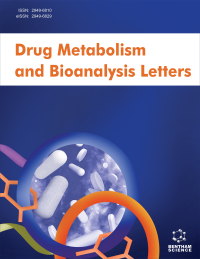Drug Metabolism and Bioanalysis Letters - Current Issue
Volume 17, Issue 3, 2024
-
-
Quantum Computing Assays: Advancing Drug Metabolism Studies and Drug Delivery Design
More LessQuantum computing is poised to advance drug metabolism studies and drug delivery system design by providing unparalleled precision in simulating molecular interactions and optimizing therapeutic strategies. In drug metabolism, quantum algorithms allow for the accurate modeling of complex enzyme dynamics, such as those involving cytochrome P450 enzymes, which play a pivotal role in drug biotransformation. T Read More
-
-
-
Interaction Risk: Green Tea Consumption in Patients Taking Alprazolam
More LessAuthors: Darshan Gowda Bharathi Srinivasa and Sunil Kumar KadiriA developing area of clinical interest is the potential interactions between drugs and herbal products. The potential risk of an interaction between green tea (Camellia sinensis) and alprazolam, a benzodiazepine that is commonly recommended for anxiety disorders, is discussed in this review. Numerous bioactive components included in green tea, such as caffeine and catechins, may alter the pharmacokinetics of alprazolam b Read More
-
-
-
The Role of Serotonin Modulators in Nicotine Reward and Reinforcement: A Conditioned Place Preference Investigation
More LessAuthors: Rajkumar Tiwari, Bhawna Sharma, Rohit Pandey, Gaurav Kumar and Khushboo BhardwajBackgroundNicotine addiction remains a significant public health challenge, driving the need for effective treatment strategies. While various pharmacological approaches have been explored, targeting neurotransmitter and neuromodulator systems offers a promising avenue. These systems, particularly those involving dopamine, play a pivotal part in interceding the rewarding effects of nicotine and the development Read More
-
-
-
Development and Optimization of Sustained-Release Matrix Tablets of Diclofenac Sodium Using Carboxymethylated Chitosan Through Systematic Application of Design of Experiments
More LessAuthors: Debabrata Ghosh Dastidar, Amit Biswas, Arunima Das, Shovan Naskar and Rupam MahishPurposeThe study aimed to develop and optimize a sustained-release matrix tablet of diclofenac sodium (50 mg) using carboxymethylated chitosan (CMCS) as the matrix-forming polymer, in combination with hydroxypropyl methylcellulose (HPMC). The research investigated the impact of CMCS (50-200 mg) and HPMC (150-300 mg) composition on the critical quality attributes of the sustained-release matrix tablets.MethodsA 2-fa Read More
-
-
-
Evaluating the Influence of St. John’s Wort on Naproxen Pharmacokinetics and Pharmacodynamics: A Drug Interaction Assessment
More LessAuthors: Keerthana S. Halumane and Sunil Kumar KadiriIntroductionRheumatoid arthritis (RA) is a chronic autoimmune disease which leads to pain and disability that may trigger anxiety and sleep disturbances. Naproxen and St. John’s Wort concomitant administration in RA and anxiety raises the question of safety due to a potential drug interaction.Materials and MethodsAlbino Wistar rats were treated with naproxen and St. John’s Wort for 30 days. The study involved the Read More
-
-
-
Biotransformation of Hydrocortisone by Mucor hiemalis and In silico Study of the Produced Metabolite against 11β-Hydroxysteroid Dehydrogenase Type I
More LessAuthors: Bahman Nickavar and Maryam MehmannavazBackgroundMicrobial biotransformation of steroids is a valuable method for producing active pharmaceuticals or potentially active steroids, and fungi serve as powerful biocatalysts in this process. On the other hand, in silico analyses are preliminary yet influential studies for the evaluation of compounds in the drug development process.ObjectiveThis study aimed to examine the ability of Mucor hiemalis to biotransform hydroc Read More
-
Most Read This Month Most Read RSS feed
Article
content/journals/dmbl
Journal
10
5
false
en


